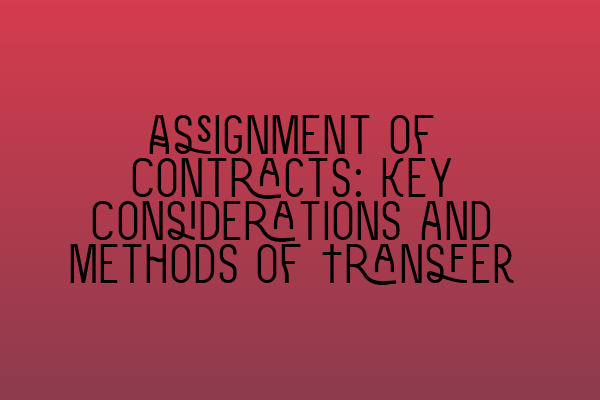Assignment of Contracts: Key Considerations and Methods of Transfer
When it comes to contract law, one important concept that often comes into play is the assignment of contracts. This process involves transferring rights and obligations from one party, known as the assignor, to another party, known as the assignee. However, the assignment of contracts is not a simple matter and requires careful consideration of the various legal and practical aspects involved.
Key Considerations
Before diving into the methods of transfer, it is important to understand the key considerations when it comes to assigning contracts. Here are some factors to keep in mind:
- Contractual Provisions: The original contract may contain specific provisions relating to assignment. These provisions can either restrict or allow the assignment of the contract. It is crucial to thoroughly review the original contract to determine the extent to which assignment is permitted.
- Consent: In many cases, the consent of all parties involved is required for a valid assignment. It is essential to obtain written consent from the assignor, the assignee, and the other party to the contract. This written consent should clearly state the intention to assign the contract and the responsibilities of the assignee.
- Notice: Giving notice of the assignment is an important step to ensure transparency and avoid any potential disputes. The assignor should provide written notice to the other party involved in the contract, informing them of the assignment and providing the necessary details about the assignee.
- Liabilities and Rights: When assigning a contract, it is vital to understand that all liabilities and rights associated with the contract are transferred to the assignee. The assignor is generally released from any future obligations under the contract once the assignment is complete.
- Third-Party Rights: In some instances, third parties may have rights or interests in the contract that could be affected by the assignment. It is crucial to consider the impact of the assignment on these third parties and take the necessary steps to mitigate any potential risks.
Methods of Transfer
Now that we have explored the key considerations, let’s delve into the various methods of transferring contracts:
Complete Assignment
A complete assignment involves the transfer of all rights and obligations under the contract from the assignor to the assignee. This method is commonly used when the assignor wants to entirely release themselves from the contract.
For example, let’s say Company A has a contract with Company B to provide marketing services. If Company A assigns the contract to Company C through a complete assignment, Company C assumes all responsibilities and benefits of the original contract, while Company A is no longer involved.
Partial Assignment
In contrast to a complete assignment, a partial assignment involves the transfer of only specific rights or obligations under the contract. This method allows for a more flexible arrangement between the assignor and the assignee, as it allows them to divide the contractual rights and obligations as desired.
For instance, in a construction contract, the assignor may choose to assign the responsibility of electrical works to one assignee, while another assignee takes on the plumbing works. This allows for specialization and potentially streamlines the project’s execution.
Novation
Novation is another method of transferring contracts that involves the substitution of one party with another. Unlike assignment, where the original contract remains intact, novation results in the creation of an entirely new contract between the remaining party and the new party.
In a novation, the original party is released from any future obligations, and the new party assumes both the rights and responsibilities of the original party. This method is commonly used when a party wants to completely replace one party with another, such as when a business is sold or a partnership undergoes changes in its ownership structure.
Conclusion
As you can see, the assignment of contracts is a complex process that requires careful consideration and adherence to legal requirements. Key considerations such as contractual provisions, consent, notice, liabilities and rights, and third-party rights should be carefully evaluated before proceeding with any transfer. Additionally, understanding the different methods of transfer, including complete assignment, partial assignment, and novation, will help you determine the most suitable approach for your specific situation.
If you found this article helpful, you may also be interested in our other related articles:
